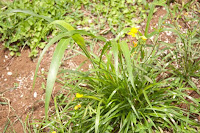Plants decide where they should grow, that's why seedballs make perfect sense
All the cover crops are big and some are taller than myself. I went to care for tea plants that are totally buried in cover crop jungle. I cut back some 7ft tall cover crop grass and uncover tea plants. While I was doing this, I realized that certain cover crop plant grow only in certain places.
Whether it's soil condition or shading or moisture condition, some plants just don't do well while some other ones grow prolific. For example, grasses grow in rich soil much better than legumes or vetch and clover type. Then I also realized that when I planted cover crop there was some rich soil and some poor soil. Parts of the field where some trees dropping their leaves were naturally richer in soil condition and it made total difference in how cover crops grew.
Typically richer soil favored grasses and even legumes germinate, they tend to get overgrown by grasses while poor soil favored legumes and grasses stay small and look stunted. The same thing happened throughout our fields.
Mr. Fukuoka describes in his book that his trial to find good cover crop was long journey, tried so many and learned from trial and error. He finally reached conclusion that seedballs as a mix of various types of seeds are the best way to build soil naturally. They find when to germinate and where to grow.
We have tried so many different types of cover crops from commercial high yield cover crop to vegetables to neighborhood noxious weeds. Over time I realized that our approach in establishing cover crop system was more and more similar to seedball style. In natural farming we just need to know that we don't know what nature does. We can provide options and nature will pick which one to use.
Whether it's soil condition or shading or moisture condition, some plants just don't do well while some other ones grow prolific. For example, grasses grow in rich soil much better than legumes or vetch and clover type. Then I also realized that when I planted cover crop there was some rich soil and some poor soil. Parts of the field where some trees dropping their leaves were naturally richer in soil condition and it made total difference in how cover crops grew.
Typically richer soil favored grasses and even legumes germinate, they tend to get overgrown by grasses while poor soil favored legumes and grasses stay small and look stunted. The same thing happened throughout our fields.
Mr. Fukuoka describes in his book that his trial to find good cover crop was long journey, tried so many and learned from trial and error. He finally reached conclusion that seedballs as a mix of various types of seeds are the best way to build soil naturally. They find when to germinate and where to grow.
We have tried so many different types of cover crops from commercial high yield cover crop to vegetables to neighborhood noxious weeds. Over time I realized that our approach in establishing cover crop system was more and more similar to seedball style. In natural farming we just need to know that we don't know what nature does. We can provide options and nature will pick which one to use.

Comments
Post a Comment